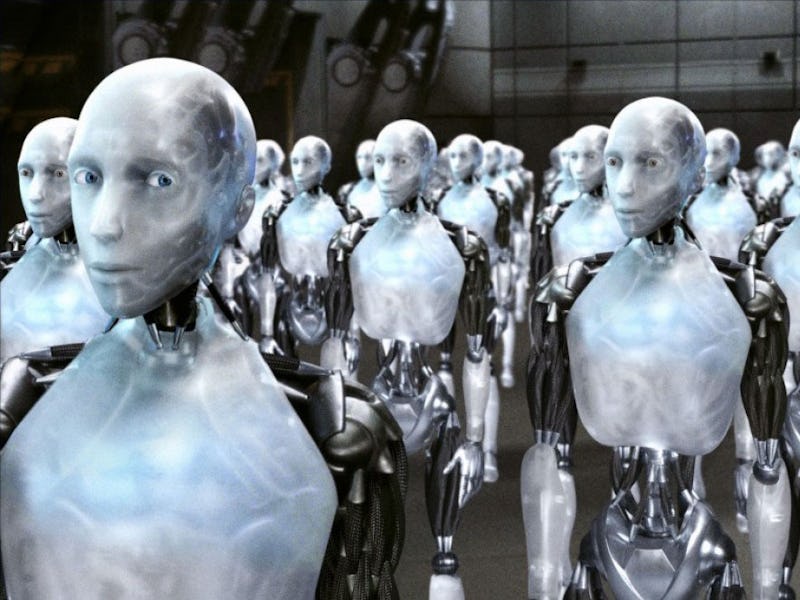You need to watch the most underrated robot sci-fi movie on Amazon Prime ASAP
This robot movie from director Alex Proyas is an unfairly underrated sci-fi blockbuster.

When it was first released, the Alex Proyas-directed sci-fi blockbuster was widely derided for its lack of connection to Isaac Asimov’s original short-story collection, from which it draws its title. The movie opened itself up for derision by claiming it was “suggested by” Asimov’s stories; Scott Tobias of The AV Club countered that it was “two stops removed from ‘based on’ and ‘inspired by.’”
But there’s more than meets the eye where I, Robot is concerned, and it’s not merely a victim of false advertising. I, Robot stands as the biggest budget Proyas has received in his career, and the experience of making it drove him away from Hollywood for years. As it stands, the film is a smart blockbuster that feels entirely of its time while tapping into more modern insecurities. Within its tensions are also visible a constant push-and-pull between Proyas and the studio.
At the center of the story is Will Smith's gigawatt charm (which he knowingly bolsters with a tasteful nude scene). There’s a clever visual sensibility to the film, moving between milky-white futurism and a gritty, grounded Chicago. And then there’s the plot, which does more than simply pay homage to Asimov’s ideas.
I, Robot marks the end of the first phase of Smith’s career. Movies like Bad Boys, Independence Day, and Ali had made him one of the most bankable stars in Hollywood, and his $28 million payday on I, Robot reflected that status. For Proyas, who’d previously made smart genre films like The Crow and Dark City, it was a chance to see what he could really do with a studio budget.
Beyond the lure of a sizable paycheck, Smith said in interviews at the time that he was attracted to working with Proyas, who approached the movie as a small art film. In I, Robot, Smith plays Detective Del Spooner, a Chicago cop who has personal reasons for hating popular service robots made by the definitely not-evil mega-corporation U.S. Robotics.
A scene from I, Robot.
So when Spooner is summoned by a hologram of a U.S. Robotics scientist Alfred Lanning (James Cromwell), only to learn of his sudden death, it’s no surprise the detective immediately suspects a robot’s involvement in what everyone else is calling a suicide. Those in Spooner’s life, from his caring grandmother (Adrian Ricard) to his trusted lieutenant (an underused Chi McBride), accuse him of displaying prejudice against the machines.
U.S. Robotics, more than anything, wants the case of the dead scientist to go away, given that they’re on the verge of releasing their latest model, the NS-5 robot, which offers unprecedented imitations of human behavior. This advancement makes Spooner suspicious, but the company’s stand-offish CEO (Bruce Greenwood) refers the detective back to the company’s Three Rules of Robotics, at the heart of robot programming (and Asimov’s mythology). These rules prevent robots from ever harming humans, even at the cost of their own mechanical lives.
But Spooner and his escort at U.S. Robotics, a scientist named Susan Calvin (Bridget Moynahan) who’s tasked with making robots appear more human, discover one bot acting out of turn. He doesn’t follow orders, evades capture, and clearly has an agenda of his own. Once this robot is eventually captured, he reveals his name is Sonny (played by a digitally imposed Alan Tudyk).
A scene from I, Robot.
In interviews around I, Robot, Smith and Proyas pointed towards an interrogation scene between Spooner and Sonny. Spooner spends the scene speculating why the robot might have killed its creator, and Sonny spends the scene defending his life, arguing with increased anger that he did not murder anyone. Tension escalates to such an extent that Sonny forcefully slams his hands on the table, leaving a notable impression.
“That scene is a six minute scene and Alex just takes his time with it,” explained Smith in an interview at the time. “You just wouldn't normally take that kind of time in a summer blockbuster, to have a movie where your hero cries about a little girl being killed by a robot. I loved the challenge of being able to make a movie with that kind of texture and depth and be able to put it out in July.”
There’s also Spooner’s car, an Audi prototype that’s practically its own character. The product placement is obvious, but the car — which uses spheres instead of wheels — is genuinely odd enough that it’s easy to cherish every second it is on screen.
Not everything in I, Robot works: a young Shia LaBeouf isn’t all that believable as a streetwise youth who can’t stop cussing. At times, it feels like action scenes were forced upon a movie that wanted to take its time examining humanity. The story, originally a standalone sci-fi murder mystery (the Asimov-related elements were worked in later), can sometimes feel like mixing oil and water.
But I, Robot explores themes that have dominated the robot sci-fi genre since, from arthouse pictures like Marjorie Prime to mega-blockbusters like Avengers: Age of Ultron. What happens when robots decide to follow their programmed-in rules to the letter? Asimov’s work is famously hard to adapt, though Apple TV is trying again soon. From I, Robot, Hollywood can learn that one need not follow a story to the letter to make sure its major themes come through.
I, Robot is now streaming on Amazon Prime.